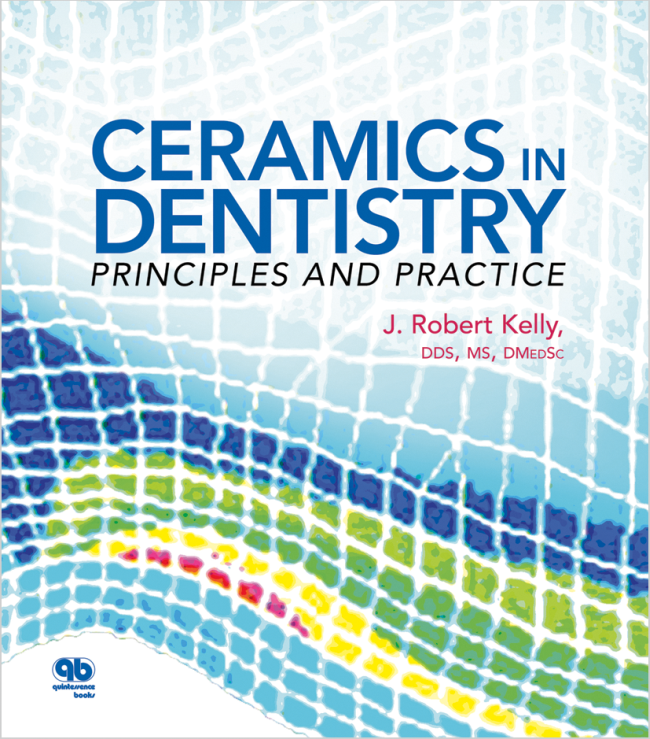The International Journal of Prosthodontics, 5/2016
DOI: 10.11607/ijp.4826, PubMed ID (PMID): 27611756Pages 496-502, Language: EnglishFalcone, Marie Elena / Kelly, J. Robert / Rungruanganut, PatchaneePurpose: It has long been taught that the hue of a patient can be taken from the canine and applied to other anterior teeth at a lower chroma. This concept does not appear to derive from published work. This study examined color relationships between in vivo maxillary central incisors and canines as a function of age.
Materials and Methods: The L*a*b* values and VITA Classical shades of the maxillary central incisor and canine of 62 subjects were determined using a handheld spectrophotometer. Linear regression analysis and t tests were used to describe the relationships of the L*a*b* values of these teeth within each patient and as a function of age.
Results: Linear regression demonstrated a significant decrease in ΔE with age (P = .056). Patient age was greater when ΔE (central-canine) > 3.3 (average age = 38.8 years) than when ΔE 3.3 (average age = 58.8 years) (t test; P = .19). ΔC decreases significantly with age (P .001). ΔH demonstrated a trend to decrease as a function of age (P = .2). ΔL remained the same over time (P = .21). Changes with age were due to central incisor differences, while the canine remained constant.
Conclusion: ΔE (incisor-canine) significantly decreases with age; mostly due to ΔC. The majority of changes for all three color coordinates are due to alterations in the central incisor. The majority of the patients in this study were found to have a different shade family (VITA Classical) for the central incisor and canine.
The International Journal of Oral & Maxillofacial Implants, 3/2016
DOI: 10.11607/jomi.4698, PubMed ID (PMID): 27183069Pages 601-609, Language: EnglishKelly, J. Robert / Rungruanganunt, PatchneePurpose: Zirconia is being widely used, at times apparently by simply copying a metal design into ceramic. Structurally, ceramics are sensitive to both design and processing (fabrication) details. The aim of this work was to examine four computer-aided design/computer-assisted manufacture (CAD/CAM) abutments using a modified International Standards Organization (ISO) implant fatigue protocol to determine performance as a function of design and processing.
Materials and Methods: Two full zirconia and two hybrid (Ti-based) abutments (n = 12 each) were tested wet at 15 Hz at a variety of loads to failure. Failure probability distributions were examined at each load, and when found to be the same, data from all loads were combined for lifetime analysis from accelerated to clinical conditions.
Results: Two distinctly different failure modes were found for both full zirconia and Ti-based abutments. One of these for zirconia has been reported clinically in the literature, and one for the Ti-based abutments has been reported anecdotally. The ISO protocol modification in this study forced failures in the abutments; no implant bodies failed. Extrapolated cycles for 10% failure at 70 N were: full zirconia, Atlantis 2 × 107 and Straumann 3 × 107; and Ti-based, Glidewell 1 × 106 and Nobel 1 × 1021. Under accelerated conditions (200 N), performance differed significantly: Straumann clearly outperformed Astra (t test, P = .013), and the Glidewell Ti-base abutment also outperformed Atlantis zirconia at 200 N (Nobel ran-out; t test, P = .035).
Conclusion: The modified ISO protocol in this study produced failures that were seen clinically. The manufacture matters; differences in design and fabrication that influence performance cannot be discerned clinically.
Keywords: CAD/CAM abutments, fatigue, implant abutments, titanium, zirconia
The International Journal of Oral & Maxillofacial Implants, 7/2014
SupplementDOI: 10.11607/jomi.2014suppl.g2.2, PubMed ID (PMID): 24660193Pages 99-116, Language: EnglishZembic, Anja / Kim, Sunjai / Zwahlen, Marcel / Kelly, J. RobertPurpose: To assess the 5-year survival rate and number of technical, biologic, and esthetic complications involving implant abutments.
Materials and Methods: Electronic (Medline) and hand searches were performed to assess studies on metal and ceramic implant abutments. Relevant data from a previous review were included. Two reviewers independently extracted the data. Failure and complication rates were analyzed, and estimates of 5-year survival proportions were calculated from the relationship between event rate and survival function. Multivariable robust Poisson regression was used to compare abutment characteristics.
Results: The search yielded 1,558 titles and 274 abstracts. Twenty-four studies were selected for data analysis. The survival rate for ceramic abutments was 97.5% (95% confidence interval [CI]): 89.6% to 99.4%) and 97.6% (95% CI: 96.2% to 98.5%) for metal abutments. The overall 5-year rate for technical complications was 11.8% (95% CI: 8.5% to 16.3%), 8.9% (95% CI: 4.3% to 17.7%) for ceramic and 12.0% (95% CI: 8.5% to 16.8%) for metal abutments. Biologic complications occurred with an overall rate of 6.4% (95% CI: 3.3% to 12.0%), 10.4% (95% CI: 1.9% to 46.7%) for ceramic, and 6.1% (95% CI: 3.1% to 12.0%) for metal abutments.
Conclusions: The present meta-analysis on single-implant prostheses presents high survival rates of single implants, abutments, and prostheses after 5 years of function. No differences were found for the survival and failure rates of ceramic and metal abutments. No significant differences were found for technical, biologic, and esthetic complications of internally and externally connected abutments.
Keywords: biologic complications, ceramics, complication rates, esthetic complications, failures, implant abutments, implant prostheses, metal, survival, systematic review, technical complications, titanium, zirconia
The International Journal of Oral & Maxillofacial Implants, 7/2014
SupplementDOI: 10.11607/jomi.2013.g2, PubMed ID (PMID): 24660195Pages 137-140, Language: EnglishWismeijer, Daniel / Brägger, Urs / Evans, Christopher / Kapos, Theodoros / Kelly, J. Robert / Millen, Christopher / Wittneben, Julia-Gabriela / Zembic, Anja / Taylor, Thomas D.The International Journal of Oral & Maxillofacial Implants, 5/2014
DOI: 10.11607/jomi.3573, PubMed ID (PMID): 25153003Pages 1193-1196, Language: EnglishKarl, Matthias / Krafft, Tim / Kelly, J. RobertPurpose: Narrow-diameter implants have become popular, as bone augmentation procedures can frequently be avoided. In order to provide implants with sufficient strength, a titanium-zirconium (Ti-Zr) alloy has recently been introduced purportedly showing improved mechanical properties as compared to commercially pure titanium (cpTi). This paper reports on the clinical and fractographic aspects of a fractured Ti-Zr implant, generally considered a rare event.
Materials and Methods: A narrow-diameter Ti-Zr implant was placed in a patient aged 66 years in the area of the maxillary right canine and used to support a removable partial denture retained by cylindrical telescopic crowns placed on the implant and on the maxillary left canine. Eleven months after successful osseointegration, the patient presented with a horizontally fractured implant. The fractured part was retrieved for fractographic analysis.
Results: The implant fractured just apical to the abutment screw, where the wall thickness of the implant is minimal. Scanning electron microscopy (SEM) analysis revealed the starting point of the fracture at the palatal aspect of the implant. No fatigue striations could be observed, indicating a brittle fracture atypical for Ti-based alloys.
Conclusions: The fractographic observations correlate with the given loading situation, which is characterized by high levels of moment loading being imposed on the implant by a rigidly retained cantilever prosthesis. Mechanical overload going beyond the approved indications for Roxolid implants (Straumann) has to be seen as primary cause for this fracture.
Keywords: implant fracture, fractography, Roxolid, telescopic crown
The International Journal of Oral & Maxillofacial Implants, 1/2013
DOI: 10.11607/jomi.2554, PubMed ID (PMID): 23377052Pages 89-95, Language: EnglishAhmad, Omaid K. / Kelly, J. RobertPurpose: There is no quantitative gold standard instrumentation to assess the quality of implant osseointegration. The purpose of this exploratory study was to evaluate the response of two devices (one based on resonance frequency analysis, the Osstell device, and another that analyzes the percussion energy response, the Periometer) to assess the primary stability of implants embedded in artificial bone models.
Materials and Methods: Standard implants were placed into polyurethane blocks of varying densities, and the two mechanical devices were challenged to test the specimen block series. Both analysis of variance and regression analysis were used to examine the output from each device over each series of specimen blocks as well as to directly compare outputs between the two devices.
Results: The stability of the implants increased with the foam density for solid block specimens. Linear regression analysis showed significant correlation between the two instruments for testing with monolithic blocks ( r2 = 0.984). Both devices also indicated that a hybrid block with the greatest density at the top provided the best implant stability versus a hybrid block with relatively low density at the top of the block. However, resonance frequency analysis readings seemed to be more dependent on the density of the top layer of the hybrid blocks.
Conclusion: Osstell and Periometer readings were in good agreement for monolithic blocks, and they were reasonably consistent when blocks of hybrid density were tested.
Keywords: bone density, dental implant, implant stability, osseointegration
The International Journal of Prosthodontics, 2/2006
PubMed ID (PMID): 16602369Pages 185-192, Language: EnglishScherrer, Susanne S. / Quinn, Janet B. / Quinn, George D. / Kelly, J. RobertPurpose: To educate dental academic staff and clinicians on the application of descriptive (qualitative) fractography for analyses of clinical and laboratory failures of brittle materials such as glass and ceramic.
Materials and Methods: The fracture surface topography of failed glass, glass fiber-reinforced composite, and ceramic restorations (Procera, Cerestore, In-Ceram, porcelain-fused-to-metal) was examined utilizing a scanning electron microscope. Replicas and original failed parts were scrutinized for classic fractographic features such as hackle, wake hackle, twist hackle, arrest lines, and mirrors.
Results: Failed surfaces of the veneering porcelain of ceramic and porcelain-fused-to-metal crowns exhibited hackle, wake hackle, twist hackle, arrest lines, and compression curl, which were produced by the interaction of the advancing crack with the microstructure of the material. Fracture surfaces of glass and glass fiber-reinforced composite showed additional features, such as velocity hackle and mirrors. The observed features were good indicators of the local direction of crack propagation and were used to trace the crack back to an initial starting area (the origin).
Conclusion: Examples of failure analysis in this study are intended to guide the researcher in using qualitative (descriptive) fractography as a tool for understanding the failure process in brittle restorative materials and also for assessing possible design inadequacies.




